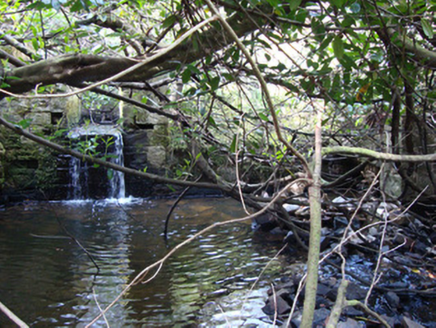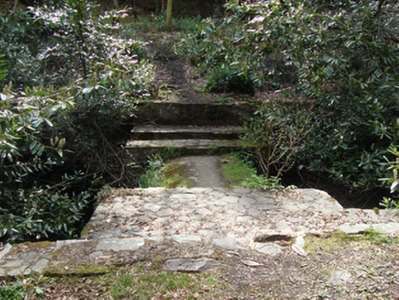Survey Data
Reg No
41401310
Rating
Regional
Categories of Special Interest
Technical
Original Use
Water pump
Date
1860 - 1900
Coordinates
265539, 330980
Date Recorded
22/04/2012
Date Updated
--/--/--
Description
Hydraulic dam and ram, constructed c.1880. No longer in use. Coursed rubble and cut limestone walls to channel to south of concrete, hemispherical dam wall, and to walls of channel leading to drop to lower level of river to east. Coursed rubble limestone walls to north-east containing square-headed opening with wrought-iron gate in abutment wall. Associated hydraulic ram (not accessible at time of survey) believed to be contained within abutment wall. Rubble stone steps to lower level of river from north-east bank. Series of former sluice gates from west and south-west. Coursed rubble sluice wall, some with socket for timber sluice gate, some with remains of wrought-iron sluice gate fixings. Dam located to south-east of remains of Rossmore Castle and walled garden, on bend of river flowing from west to north.
Appraisal
The hydraulic dam and ram are located to the east of the remains of Rossmore Castle and are marked on the 1908 Ordnance Survey map as 'Hydraulic Ram'. Rossmore Castle, now in the ownership of Coillte, is arguably one of the most interesting demesne complexes in the county of Monaghan. The demesne also contains gates and lodges, a mausoleum, bridges, walled garden, and wells. In addition, the park has the remains of some pioneering engineering features, many named on the 1908 map, including a pumping works, a gas works, and of course this hydraulic dam and ram, used for generating electricity and pumping water. A hydraulic ram is a cyclic hydro-powered water pump that works by building up pressure within a cylinder to force water out in smaller, faster, jets than it entered. The ram was typically used to lift water uphill. The hydraulic ram was used to pump water to Rossmore Castle, which is located on a height to the north-west of this point of the river. The dam, ram, and sluice gates, illustrate the advanced engineering works undertaken at Rossmore Castle in the late nineteenth century, particularly regarding the manipulation of water courses.



